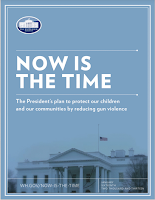 |
Map of shooting incidents courtesy Mother Jones;
interactive version on the website. |
Much of the commentary on Sandy Hook has highlighted the rise in the number of public shooting incidents in the course of the last few years. Some of the aggregate data on the shootings can be found on Mother Jones or on the Citizens Crime Commission of New York City website. Does the fact that there seem to have been many recent incidents of mass murders and spree killings of this sort mean that we have a phenomenon we need to worry about in a systematic way? We are, of course, saddened, heartbroken, angry–but should we also be afraid?
The answer to that question depends on how one defines “phenomenon” and how one decides what to worry about. Since there is no official measurement for “worrisomeness that merits criminalization/heightened enforcement”, the extent to which we take steps to criminalize, police, and curtail rights depends on how severe we assess the threat to be. And that is, generally speaking, a question that involves politicians, the media, and the public.
One criminological concept that pops up in these discussions quite often is moral panic. A term coined by Stanley Cohen in his classic book about the Mods and the Rockers, it is “a condition, episode, person or group of persons [who] become defined as a threat to societal values and interests.” Cohen emphasized that the panic is amplified by media reports and often culminates in a call to do something on the matter. Goode and Ben Yehuda identify consensus, a heightened level of concern, and hostility, as important factors in a moral panic.
Unmentioned in the definition, but implied in the literature, is the assumption that the panic is exaggerated. That is, that there is no real cause for concern, or at least not to the extent that justifies criminalization or curtailment of personal rights.
In 1999, Ronald Burns and Charles Crawford published an article on Crime, Law and Social Change about school shootings as a moral panic. The article shows the interaction between politicians, media reports, and public outcry, in the aftermath of Columbine. As they analyze the political and media attention to school shootings, they offer the following to show that the concern was disproportionate:
Were these massive societal responses to what were indeed heinous, threat- ening offenses against schoolteachers and students justified? A closer look at statistics regarding juvenile crime and more specifically school violence suggests that what occurred was arguably an overreaction to the situation. For example, consider the following sample of recent findings regarding juvenile crime in the context of the aforementioned societal responses:
- There has been no increase in the number of children under age 13 arrested for homicides in the U.S. In 1965, 25 children under age 13 were arrested for homicides and in 1996 it was 16, a 36 percent decline (Donahue, Vincent and Schiraldi, 1998).
- Overall, fewer than 3 percent of the killings in America in 1996 involved someone under age 18 killing someone else under age 18 (FBI, 1997).
- FBI data suggest that national youth violence arrests went down both in number and in share of total youth arrests between 1992 and 1996 (“Violent youth . . .,” 1998).
- Three of four young murder victims – 90% of them under age 12 and 70% of them agged 12–17 – are killed by adults, not by juveniles (Males, 1998).
While one cannot discount the substantial increases in juvenile crime during the late 1980s, recent reports suggest that the problem is diminishing. Bernard (1999) suggests that although there exists conflicting trends, the most consist- ent interpretation is that juvenile crime, with the exception of homicide, has declined by about one-third over the last twenty years. In their chapter titled: “Juvenile Superpredators: The Myths of Killer Kids, Dangerous schools and a Youth Crime Wave,” Kappeler, Blumberg and Potter (2000) elaborate upon these and similar findings. There has been a similar, and probably more pro- nounced decrease in the amount of school violence. Consider the following:
- There were 55 school shooting deaths in the 1992–1993 school year; 51 in 93–94; 20 in 1994–995; 35 in 1995–96, 25 in 1996–97; and 40 in 1997–98 (Lester, 1998). There are more than 50 million students and more than 80,000 schools across the country (Sanchez, 1998).
- A child’s chances of being struck by lightning are greater than the million- to-one odds of being killed in school. The number of children killed by gun violence in schools is about half the number of Americans killed annually by lightning (Byrne, 1998).
- According to PRIDE, the number of students bringing guns to school dropped from 6 percent in 1993–94 to 3.8 percent in 1997–98 (“1 million . . .,” 1998).
- In Los Angeles, 15,000 people have been murdered during the 1990s. Five occurred at school. Of 1,500 murders in Orange County during the 1990s, none took place at school. Institutions in these areas serve 2 million students, including 700,000 teenagers (Males, 1998).
- The United States has approximately 338 million children between the ages of ten and seventeen who attend roughly 20,000 secondary schools. In 1994, there were no school shootings in which more than a single person was killed; in 1997, there were four; and in 1998 there were two (Glassman, 1998).
Available data from sources such as the Centers for Disease Control, National School Safety Center, National Center for Education Statistics, U.S. Depart- ment of Education, and The Sourcebook of Criminal Justice Statistics support the suggestion that the recent school shootings were idiosyncratic events and not part of any recognizable trend. Ironically, the shootings may have received such intense coverage because of the infrequency of these occurrences rather than their frequency (Donohue, Schiraldi and Ziedenberg, 1998).
Similar arguments can be made today. While there has been an uptick in the number of these murderous incidents, crime, and violent crime in particular, is on the decline nationwide. And while the prospect of falling victim, or losing a loved one, to a mass shooting is terrifying and horrible, the odds of this occurrence are still very, very low.
Does that mean that the concern is unjusfied? Disproportionate? I don’t think so. I think that fear of crime is an entirely real and reasonable response to such an incident. We respond strongly to experiences and events not just on account of their frequency, but also on account of their magnitude and meaning. So, yes. We are sad, and heartbroken, and angry, and have every right to be sad, and heartbroken, and angry.
The next question to tackle, after we dry our tears and sit at the policymaking desk, is how do we want the odds of another horrific occurrence to shape and affect the architecture and organizational culture of our schools. Do we want more metal detectors? More armed guards? More search points at the entrance to schools? How would that affect the learning experience, intellectual growth, and social interactions of the nation’s children? All of those balances will have to be done delicately and carefully, because, by contrast to a horrifying mass murder scene, their effects will be subtle and intangible. And we should keep in mind, that it is okay to be sad, and heartbroken, and angry, and at the same time, wise and thoughtful in our policymaking reactions.





